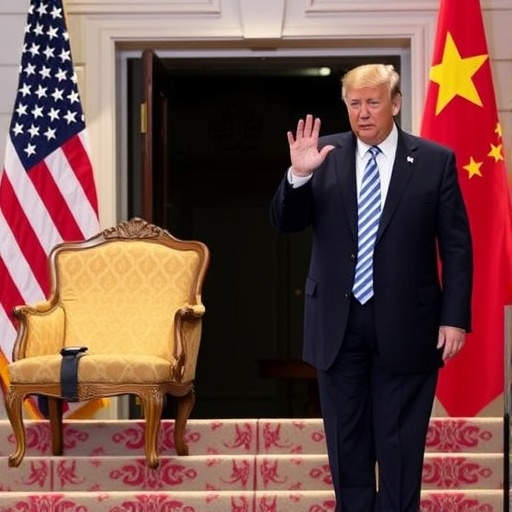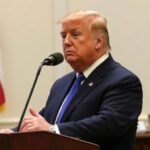President Trump Heads to Asia: High-Stakes Trade Talks Aim to Ease China Tariffs and Boost Deals
In a bold move to reshape global trade dynamics, President Donald Trump is set to embark on a pivotal Asia visit this week, focusing on intensive trade talks with key allies and a renewed push for a landmark deal with China. The trip, announced by the White House, comes at a critical juncture amid escalating tensions over tariffs and a ballooning U.S. trade deficit, with Trump vowing to secure commitments for increased agricultural purchases and tariff reductions that could unlock billions in economic gains.
- Trump’s Packed Asia Itinerary: From Tokyo to Beijing for Trade Diplomacy
- Reviving Stalled U.S.-China Negotiations: Tariffs in the Crosshairs
- Allies Gear Up for Trump’s Trade Push: Strengthening Regional Partnerships
- Agricultural Windfalls on the Horizon: Billions in Exports at Stake
- Global Markets Brace for Outcomes: What Lies Ahead in Trump’s Trade Legacy
Trump’s itinerary underscores his administration’s aggressive approach to trade policy, building on previous summits that have yielded mixed results. Sources close to the negotiations reveal that the president aims to leverage personal diplomacy to break deadlocks, particularly with Beijing, where unresolved issues from the ongoing trade war continue to strain relations. This Asia visit is not just about bilateral meetings; it’s a strategic gambit to rally Asian partners against unfair practices, potentially altering the landscape of international commerce.
The announcement has already sent ripples through global markets, with U.S. stock futures ticking up slightly on expectations of de-escalation. Economists estimate that a successful China deal could add up to $100 billion to the U.S. economy annually through expanded exports, highlighting the high stakes involved in these trade talks.
Trump’s Packed Asia Itinerary: From Tokyo to Beijing for Trade Diplomacy
President Donald Trump‘s Asia visit kicks off in Tokyo, where he will hold high-level discussions with Japanese Prime Minister Fumio Kishida on strengthening economic ties. Japan, a longstanding U.S. ally, has been a focal point in Trump’s trade agenda since the 2019 U.S.-Japan Trade Agreement, which eliminated tariffs on $7.2 billion worth of American agricultural products. This time, Trump is expected to press for deeper commitments, including reduced barriers to U.S. autos and technology exports, amid concerns over Japan’s growing trade surplus with the U.S., which reached $68 billion last year.
Following Tokyo, the president’s schedule includes stops in Seoul, South Korea, to address the ongoing implementation of the U.S.-Korea Free Trade Agreement (KORUS). Renegotiated under Trump’s first term, KORUS has boosted U.S. exports by 20% since 2018, but recent disputes over steel quotas have resurfaced. White House trade advisor Robert Lighthizer is accompanying Trump and has hinted at potential revisions to ensure “fair and reciprocal” trade. In Seoul, discussions will likely cover national security alongside economics, given North Korea’s provocations and the need for unified supply chain resilience against Chinese dominance.
The centerpiece of the trip is undoubtedly the leg in Beijing, where Trump will meet with Chinese President Xi Jinping for direct trade talks. This marks the first in-person summit between the two leaders since the Phase One trade deal in 2020, which committed China to purchase $200 billion in U.S. goods but fell short by 40% due to the pandemic and other factors. Trump has repeatedly criticized China for intellectual property theft and currency manipulation, issues that remain unresolved. Insiders suggest the agenda includes tariff rollbacks on $370 billion in Chinese imports, with Trump aiming for a “big win” that could phase out levies imposed during the trade war.
Additional stops in Vietnam and Singapore round out the itinerary, focusing on multilateral forums like the Asia-Pacific Economic Cooperation (APEC) summit. In Hanoi, Trump will tout the U.S.-Vietnam trade relationship, which has surged to $120 billion annually, positioning Vietnam as a counterweight to China in manufacturing. Singapore meetings will emphasize digital trade and supply chain security, areas where the U.S. seeks to lead amid rising geopolitical tensions.
Reviving Stalled U.S.-China Negotiations: Tariffs in the Crosshairs
At the heart of President Trump’s Asia visit lies the thorny issue of U.S.-China trade talks, where tariffs continue to cast a long shadow over bilateral relations. Imposed starting in 2018, these duties—totaling 25% on $250 billion of Chinese goods and 7.5% on another $120 billion—were designed to address unfair trade practices but have instead fueled inflation and disrupted global supply chains. The U.S. Trade Representative’s office reports that American consumers have borne 90% of the tariff costs, amounting to an extra $50 billion annually, prompting calls for resolution.
Trump, known for his deal-making bravado, has teased a “Phase Two” agreement during recent rallies, stating, “We’re going to make a deal with China that’s going to be tremendous—bigger than anyone has ever seen.” Chinese officials, however, remain cautious, with Foreign Ministry spokesperson Zhao Lijian noting that progress depends on mutual respect. Negotiations have stalled over core demands: the U.S. wants enforceable commitments on subsidies to state-owned enterprises and market access for financial services, while China seeks tariff eliminations and exemptions from technology export controls.
Statistics underscore the urgency. The U.S. trade deficit with China hit $355 billion in 2022, up 10% from pre-trade war levels, despite tariffs. Agricultural sectors have been hit hardest; soybean exports to China plummeted 75% initially but recovered partially through the Phase One deal. Farmers in the Midwest, a key Trump constituency, stand to gain immensely from renewed purchases—China has already committed to buying $80 billion in U.S. farm goods over two years, but fulfillment lags.
Experts like Gordon Hanson from the Peterson Institute for International Economics warn that without a deal, tariffs could escalate further, potentially adding 0.5% to U.S. inflation. On the flip side, a breakthrough could stabilize prices and open doors for American tech firms, which face 60% tariffs on semiconductors exported to China.
Allies Gear Up for Trump’s Trade Push: Strengthening Regional Partnerships
Beyond China, President Trump’s Asia visit is a clarion call for U.S. allies to align on trade talks that counter Beijing’s influence. In Tokyo and Seoul, leaders are preparing to endorse Trump’s vision of a “free and open Indo-Pacific,” a framework that has evolved into economic initiatives like the Indo-Pacific Economic Framework (IPEF). Launched in 2022, IPEF now includes 14 nations representing 40% of global GDP, focusing on supply chains, clean energy, and fair labor standards.
Japan’s commitment is particularly vital; as the world’s third-largest economy, it exported $140 billion to the U.S. last year, but Trump seeks reciprocity on digital services taxes that disadvantage American firms like Google and Amazon. Prime Minister Kishida, facing domestic pressure from a weakening yen, is likely to offer concessions in exchange for U.S. investment in Japanese semiconductors—a sector critical to countering China’s chip ambitions.
South Korea, home to giants like Samsung and Hyundai, has seen its exports to the U.S. grow 15% annually under KORUS. Yet, Trump’s team is eyeing adjustments to rules of origin for autos, ensuring more U.S.-made components. Korean Trade Minister Yeo Han-gu expressed optimism, saying in a recent interview, “We value our partnership with President Trump and are ready to deepen trade ties that benefit both nations.”
In Southeast Asia, Vietnam and Singapore represent emerging fronts. Vietnam’s trade surplus with the U.S. exploded to $100 billion in 2022, drawing scrutiny for potential transshipment of Chinese goods evading tariffs. Trump plans to address this head-on, proposing enhanced customs cooperation. Singapore, a hub for finance and tech, could facilitate trilateral talks involving the U.S., China, and ASEAN, potentially leading to tariff-free zones for critical minerals.
Overall, these alliances could amplify Trump’s leverage in China negotiations. A united front from Asia’s democracies might pressure Beijing to concede on structural reforms, reshaping trade flows and reducing U.S. reliance on Chinese imports by 20-30%, according to Brookings Institution estimates.
Agricultural Windfalls on the Horizon: Billions in Exports at Stake
One of the most tangible outcomes expected from President Trump’s Asia visit is a surge in U.S. agricultural exports, particularly to China, where tariffs have long hampered farmers’ livelihoods. The Phase One deal promised $50 billion in annual purchases of American farm products, but actual buys reached only $30 billion in 2021 due to logistical hurdles and market shifts. Trump aims to rectify this, targeting commitments for soybeans, corn, pork, and beef—staples that could inject $20 billion into rural economies.
The impact is profound: Iowa, a battleground state, lost 20,000 farm jobs during the trade war’s peak, per USDA data. Today, with global food prices up 30% amid the Ukraine conflict, Asian demand offers a lifeline. Chinese importers, facing domestic shortages from floods and policy shifts, are eager for stable supplies. Negotiators are discussing tariff cuts on U.S. meats from 25% to 10%, which could double exports overnight.
Beyond China, allies like Japan and South Korea are key markets. Japan imports 60% of its beef from the U.S., valued at $2.5 billion yearly, and Trump seeks expanded quotas. In Vietnam, rice and cotton deals could open new avenues, with the country poised to become a top-10 buyer of U.S. grains.
Stakeholders are vocal. American Farm Bureau President Zippy Duvall stated, “President Trump’s trade talks are crucial for our farmers who’ve weathered the storm. A strong Asia visit could mean prosperity for generations.” Economists project that full tariff relief and purchase pledges could boost U.S. GDP by 0.2%, with ripple effects in processing and transportation sectors employing millions.
Global Markets Brace for Outcomes: What Lies Ahead in Trump’s Trade Legacy
As President Trump’s Asia visit unfolds, the world watches closely for signals of de-escalation in trade talks with China and beyond. Success could herald a new era of balanced commerce, with tariffs phased out over 18 months and agricultural deals locked in, potentially averting a recessionary spiral. Failure, however, might invite retaliatory measures, escalating costs for consumers and businesses alike.
Looking forward, the trip’s ripple effects extend to domestic politics. With midterm elections looming, Trump positions this as a win for American workers, contrasting his proactive stance against predecessors’ “weak” policies. Internationally, a robust outcome might encourage WTO reforms, addressing disputes that have plagued the body since Trump’s tenure began.
Analysts like Elizabeth Economy from the Council on Foreign Relations foresee “transformative potential” if Trump secures buy-in from allies. Supply chains could diversify, tech transfers accelerate, and U.S. exports climb to record highs. Yet, challenges persist: China’s economic slowdown and U.S. inflation at 8.5% complicate bargaining. Next steps include follow-up virtual summits in Q4 and possible G20 endorsements, setting the stage for enduring trade realignments.
In essence, this Asia visit isn’t merely diplomatic theater—it’s a pivot point for global economics, with Donald Trump‘s deal-making at its core.








